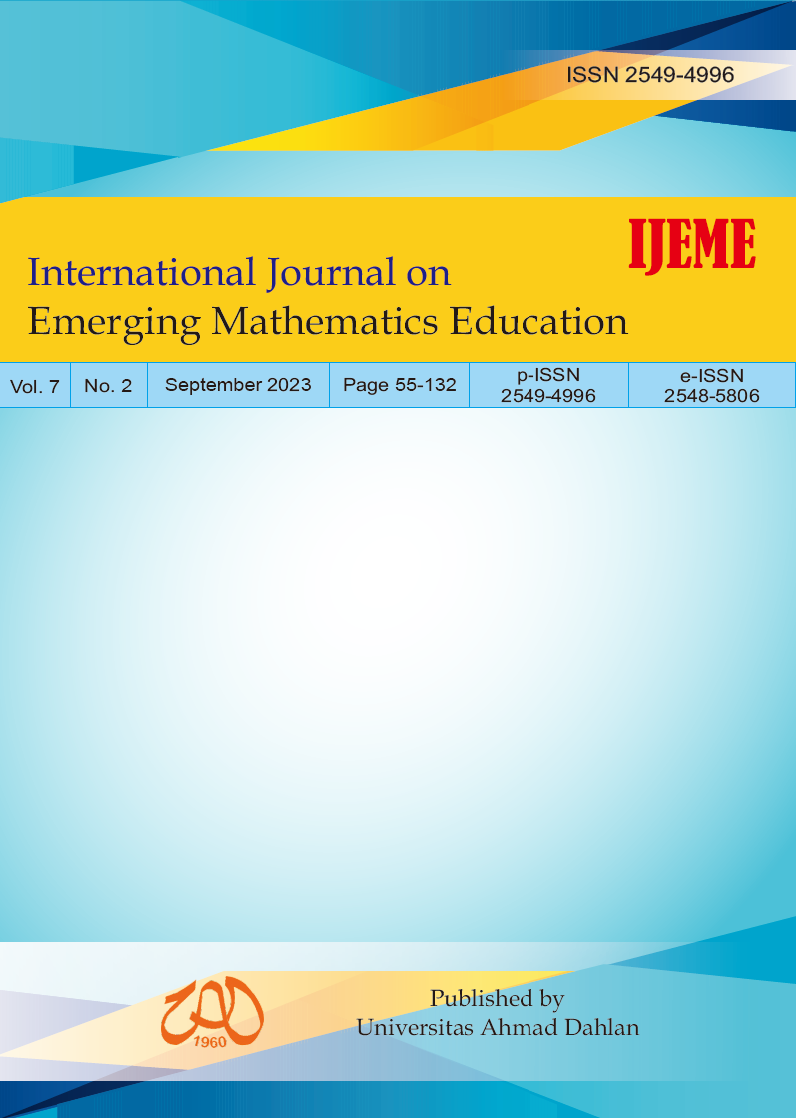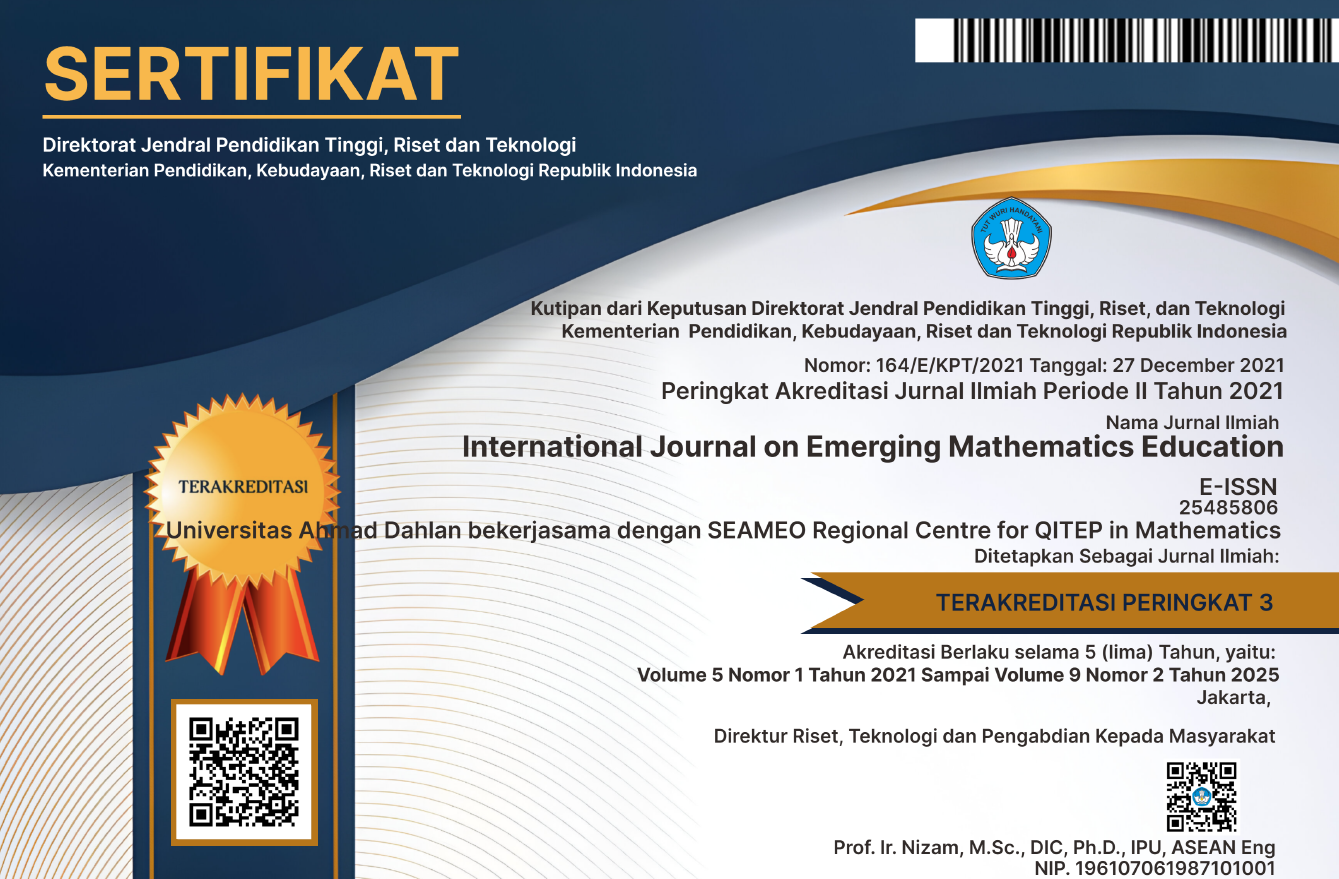Development of a rubric for assessing Multiplicative Thinking in Primary Schools in Zambia
DOI:
https://doi.org/10.12928/ijeme.v7i2.29298Keywords:
multiplicative thinking, multiplicative structure, representation, assessment, rubricAbstract
The study focuses on developing a rubric to assess Multiplicative Thinking (MT) in Zambia. Drawing from a quasi experiment with 3rd to 5th grade students from two schools, the study addressed the question: “What rubric can effectively capture the diverse range of students’ responses to multiplication and division problems in Zambia?”. Inductive content analysis was applied to examine, code and categorise students’ responses to tasks involving reading and drawing patterns, commutative property, daily context, and the inverse relation between multiplication and division. The analysis focused on the Multiplicative Structure of responses using the lens of mutual translation between representation modes. The following categories emerged: no answer, incorrect, partially correct, and correct. The rubric aims to bridge the gap between mathematics education research and practical implementation. Additionally, it aligns with Zambian assessment policy, which promotes rubric use for quality assessment.References
Baba, T., Nakawa, N., Nkhata, B., Mungalu, A., Mudenda, B., Kaabo, E., Kosaka, M., Kusaka, S., Mambwe, B., Nkharamo, C. J., & Watanabe, K. (2019). The development of a numeracy assessment instrument and its application to primary schools in Zambia. Zambia Journal of Teacher Professional Growth (ZJTPG), 5(2), 72–92
Baird, J. A., Hopfenbeck, T. N., Newton, P., Stobart, G., & Steen-Utheim, A. T. (2014). State of the field review assessment and learning (case number 13/4697). Oslo: Knowledge Center for Education.
Beck, K. (2020). Ensuring Content Validity of Psychological and Educational Tests--The Role of Experts. Frontline Learning Research, 8(6), 1-37.
Brookhart, S. M. (2003). Developing measurement theory for classroom assessment purposes and uses. Educational measurement: Issues and practice, 22(4), 5-12.
Clark, F. B., & Kamii, C. (1996). Identification of multiplicative thinking in children in grades 1–5. Journal for Research in Mathematics Education, 27(1), 41-51.
De Lange, J. (2007). Large-scale assessment and mathematics education. Second handbook of research on mathematics teaching and learning, 2, 1111-1144.
Götze, D., & Baiker, A. (2021). Language-responsive support for multiplicative thinking as unitizing: results of an intervention study in the second grade. ZDM–Mathematics Education, 53(2), 263-275.
Hodgson, J., Coe, R., Brown, M., & Küchemann, D. (2014). Improving students' understanding of multiplicative reasoning and algebra: Did the ICCAMS intervention work? In S. Pope (Ed.), Proceedings of the 8th British Congress of Mathematics Education, (pp. 167-174). https://bsrlm.org.uk/wpcontent/uploads/2016/09/BCME8-Full.pdf
Hurst, C. (2017). Children have the capacity to think multiplicatively, as long as…. European Journal of STEM Education, 2(3), 1-14.
Hurst, C., & Huntley, R. (2020). Distributivity, Partitioning, and the Multiplication Algorithm. Journal of Research and Advances in Mathematics Education, 5(3), 231-246.
Hurst, C., & Hurrell, D. (2014). Developing the big ideas of number. International Journal of Educational Studies in Mathematics, 1(2), 1-18.
Kapambwe, W. M. (2010). The implementation of school based continuous assessment (CA) in Zambia. Educational Research and Reviews, 5(3), 99.
Kaufman, O. T. (2018). The Problem of Distinguishing Multiplicative from Additive Reasoning in Primary School Classroom Context. European Journal of Science and Mathematics Education, 6(3), 100-112.
Klenowski, V. (2009). Assessment for learning revisited: An Asia-Pacific perspective.
Larsson, K. (2015). Connections for learning multiplication. In International Symposium: Elementary Maths Teaching (SEMT'15), Prague, Czech Republic, August 16-21, 2015 (pp. 202-211). Charles University.
Mainali, B. (2021). Representation in teaching and learning mathematics. International Journal of Education in Mathematics, Science and Technology, 9(1), 1-21.
Mayring, P. (2014). Qualitative content analysis: theoretical foundation, basic procedures and software solution.
Ministry of Education. (1996). Educating our future: National Policy on education. The Ministry of Education of Zambia.
Ministry of Education (2023). Zambia Education Curriculum Framework (Validation Edition). Curriculum Development Centre.
Ministry of Education, Science, Vocational Training and Early Education (2013). Zambia Education Curriculum Framework. Curriculum Development Centre.
Ministry of Education, Science, Vocational Training and Early Education (2013). Zambia Education Curriculum Framework 2013. Curriculum Development Centre.
Ministry of Education, Science, Vocational Training and Early Education (2013). Mathematics Grades 1 to 7 Syllabus. Curriculum Development Centre.
Ministry of General Education (2017). Learning Achievement at the Middle Primary School Level: Zambia Grade 5 National Assessment Survey Report of 2016. MoGE.
Ministry of General Education (2020). Standardized Terminologies and Concepts For Mathematics and Science in Zambian Languages: ECE and Grades 1 – 4. Curriculum Development Centre.
Mulenga-Hagane, M., Daka, H., Msango, H. J., Mwelwa, K., & Kakupa, P. (2019). Formative assessment as a means of improving learner achievement: lessons from selected primary schools of Lusaka, Zambia.
Mulligan, J., & Watson, J. (1998). A developmental multimodal model for multiplication and division. Mathematics Education Research Journal, 10(2), 61-86.
Mulligan, J., & Watson, J. (1998). A developmental multimodal model for multiplication and division. Mathematics Education Research Journal, 10(2), 61-86.
Nakahara, T. (2008). Cultivating mathematical thinking through representation. In Utilizing the representational system. Talk given at the APEC-Tsukuba International Conference (III), Tsukuba, Japan. Retrieved November (Vol. 17, p. 2019).
Nakawa, N. (2012). Classroom interaction in Grade 5 and 6 mathematics classrooms in two basic schools in Zambia. In T. Tso (Ed.), Proceedings of the 36th conference of the international group for the psychology of mathematics education, 3, 257–264. PME
National Council of Teachers of Mathematics. (2014). Principles to actions: Ensuring mathematical success for all. NCTM.
Siegler, R. S., Duncan, G. J., Davis-Kean, P. E., Duckworth, K., Claessens, A., Engel, M., ... & Chen, M. (2012). Early predictors of high school mathematics achievement. Psychological science, 23(7), 691-697.
Siemon, D., Banks, N., & Prasad, S. (2018). Multiplicative thinking: A necessary STEM foundation. In STEM education: An emerging field of inquiry (pp. 74-100). Brill.
Siemon, D., Banks, N., & Prasad, S. (2018). Multiplicative thinking: A necessary STEM foundation. In STEM education: An emerging field of inquiry (pp. 74-100). Brill.
Siemon, D., Callingham, R., & Day, L. (2021). The development and validation of two new assessment options for multiplicative thinking.
Breed, D. S. J. I. M., & Virgona, J. (2006). THE DERIVATION OF A LEARNING ASSESSMENT FRAMEWORK FOR MULTIPLICATIVE THINKING. International Group for the Psychology of Mathematics Education, 113.
Seel, N. M. (Ed.). (2011). Encyclopedia of the Sciences of Learning. Springer Science & Business Media.
Uchida, T. (2009). The diagnostic evaluation of pupils’ performance in basic school in Zambia: Focusing on discrimination of performance and educational suggestiveness. Journal of International Cooperation in Education, 12(2), 1-12.
Downloads
Published
Versions
- 2025-01-13 (3)
- 2025-01-13 (2)
How to Cite
Issue
Section
License
Copyright (c) 2024 Arthur Mungalu

This work is licensed under a Creative Commons Attribution-ShareAlike 4.0 International License.
License and Copyright Agreement
In submitting the manuscript to the journal, the authors certify that:
- They are authorized by their co-authors to enter into these arrangements.
- The work described has not been formally published before, except in the form of an abstract or as part of a published lecture, review, thesis, or overlay journal. Please also carefully read the International Journal on Emerging Mathematics Education (IJEME) Author Guidelines at http://journal.uad.ac.id/index.php/IJEME/about/submissions#authorGuidelines
- That it is not under consideration for publication elsewhere,
- That its publication has been approved by all the author(s) and by the responsible authorities, tacitly or explicitly, of the institutes where the work has been carried out.
- They secure the right to reproduce any material that has already been published or copyrighted elsewhere.
- They agree to the following license and copyright agreement.
Copyright
Authors who publish with the International Journal on Emerging Mathematics Education (IJEME) agree to the following terms:
- Authors retain copyright and grant the journal the right of first publication with the work simultaneously licensed under a Creative Commons Attribution License (CC BY-SA 4.0) that allows others to share the work with an acknowledgment of the work's authorship and initial publication in this journal.
- Authors are able to enter into separate, additional contractual arrangements for the non-exclusive distribution of the journal's published version of the work (e.g., post it to an institutional repository or publish it in a book), with an acknowledgment of its initial publication in this journal.
- Authors are permitted and encouraged to post their work online (e.g., in institutional repositories or on their website) prior to and during the submission process, as it can lead to productive exchanges, as well as earlier and greater citation of published work.
![]()
Ciptaan disebarluaskan di bawah Lisensi Creative Commons Atribusi-BerbagiSerupa 4.0 Internasional.





